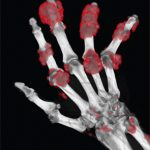
Dr. FitzGerald
“I reserve anti-IL-1 blockade with anakinra for those rare patients who have either failed prior therapies or cannot tolerate or have experienced severe adverse events with colchicine, NSAIDs and steroids,” says Dr. Helfgott. In contrast to glucocorticoids, anakinra does not exacerbate diabetes, and it does not carry the same cardiovascular risks as NSAIDs, nor the same dosing concerns of colchicine in kidney disease.2
However, anakinra is not an option at all institutions. Lisa K. Stamp, MBChB, FRACP, PhD, a rheumatologist and a professor of medicine at the University of Otago, Christchurch, New Zealand, notes that anakinra is not available in her country or in many other parts of the world. Instead, Dr. Stamp says, ACTH can be very useful in situations in which these other agents are not advised. It has an excellent safety profile, and its anti-inflammatory action acts in a steroid-independent manner with less immunosuppression than steroids, making it a suitable choice where steroids are a concern.3
Managing Pegloticase
A key tenet of gout treatment is decreasing serum urate levels via urate-lowering therapies, typically allopurinol. But some patients fail to achieve their serum urate target and continue to have frequent gout flares, even after trying xanthine oxidase inhibitor treatment and uricosurics.
For patients who are out of other choices, switching to pegloticase (PEGylated uricase) is an option. Uricase converts urate to a product readily excreted by the kidneys.
“Although pegloticase can be highly effective for select patients who have advanced, severe, tophaceous arthritis, there are many hoops to pass through for this drug to be effective,” says Dr. Helfgott. “The clinician must contend with a plethora of adverse reactions, including loss of efficacy and the potential for severe infusion reactions.”
Like other enzyme-replacement therapies, pegloticase often induces anti-drug antibodies that can cause major hypersensitivity reactions. These antibodies can also reduce response rates to the drug, as well as lead to eventual rising uric acid levels in an initially responsive patient. But some recent reports suggest that immunomodulating therapy (e.g., with methotrexate or mycophenolate mofetil) substantially increases rates of response.4
Because pegloticase is usually started as a treatment of last resort, Dr. FitzGerald explains, he universally employs immunomodulation in patients taking pegloticase to reduce the risk of antibody development and drug failure.
However, several available immune-modulating drugs, such as methotrexate and leflunomide, carry a risk of hepatotoxicity and severely limit available choices for immunomodulation, notes Dr. Helfgott, which may be an issue for some patients with gout.
Dr. FitzGerald does not consider pegloticase a long-term option because the cost is prohibitive. He treats most patients until gouty tophi have resolved. But he also notes the choice to stop the medication partly depends on the availability of viable serum urate-lowering therapies for a specific patient based on contraindications and their previous response. If no other options are available, he may continue pegloticase a little longer to significantly lower residual amounts of monosodium urate crystals. He has also treated patients who lack any other options for urate-lowering therapies by cycling pegloticase off and on.
Dr. FitzGerald also notes that he has used clinical exams to evaluate crystal burden, but ultrasound or dual-energy computed tomography (DECT) would also be reasonable choices to determine end of treatment.
Diagnosis in Atypical Patients
Most commonly, patients with gout present with pain affecting the peripheral joints, often with a monoarticular pattern (especially the first metatarsophalangeal joint), in conjunction with hyperuricemia. However, some patients present with polyarticular small joint involvement or other atypical patterns, which can pose a significant diagnostic challenge.
These atypical presentations may especially be found in certain groups, such as the elderly, patients with enzyme deficiencies, those with prosthetic implants and those on immunosuppressive therapy.5 Gout can also mimic, and sometimes coexist with, other arthropathies, further complicating diagnosis. And hyperuricemia may be absent in up to 42% of patients presenting with their first gout flare.6


